Innovating energy delivery for more efficient composites manufacturing
Heraeus Noblelight develops HUMM3 and Black IR technologies for faster, safer, more uniform processing.

This is my second blog in this pre-CAMX 2019 series which highlights key technologies that were actually exhibited at CAMX 2018. This blog centers on Heraeus Noblelight’s new black.infrared system, a novel type of system for composites processing, and its humm3 technology, which is replacing laser and infrared heaters in automated fiber placement (AFP) machines.
Innovating with light
Heraeus Noblelight innovates a wide range of industrial processes using the power of light. To give some background, all light is electromagnetic radiation (EMR) and has an inherent wavelength and frequency, as can be seen in the diagram below. Heraeus Noblelight develops devices that use light along a large portion of this spectrum, ranging from infrared (IR) emitters to LED lamps and ultraviolet (UV) systems, as well as arc and flash lamps.
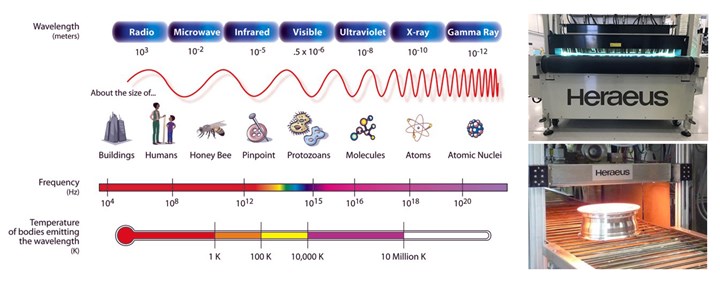
Light along the Electromagnetic Spectrum is used for heating and processing.
SOURCE | https://mynasadata.larc.nasa.gov/basic-page/electromagnetic-spectrum-diagram (left) and Heraeus (right).
In composites, UV and infrared (IR) systems have been used for decades, as can be seen in the example below. The black.infrared system, however, is new technology.
- Sunrez developed UV-cure technology for resin infusion and composite repair in the 1990s.
- UV-cured epoxy coatings are standard in many industries.
- UV-cured epoxy resin is also being used by continuous fiber 3D printing pioneers such as Continuous Composites and moi composites.
- IR heating is very common in automated composites production lines where 2D tailored blanks need to be preheated before preforming and/or preforms need to be preheated before stamping and overmolding.
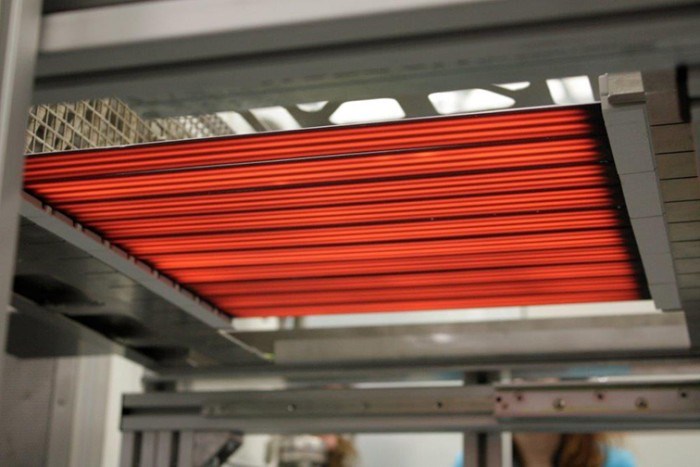
Heraeus Noblelight’s black.infrared heating system for composites. SOURCE | Heraeus Noblelight
Black.infrared
Heraeus Noblelight exhibited its new black.infrared system at CAMX 2018. “It is a medium wave IR emitter that delivers a lot of power in a small volume,” explains Bruce Fricks, senior sales manager for IR systems, Heraeus Noblelight America, LLC. Although Heraeus Noblelight is headquartered in Hanau, Germany, its U.S. division for IR and flash lamp systems is based in Buford, Georgia while its U.S. division for UV systems is based in Gaithersburg, Maryland.
“Usually, for a medium wave IR emitter, you’re more toward a power density of 60 kW/m2,” says Fricks, “but ‘Black IR’ achieves 200 kW/m2. IR is a much more efficient means of getting energy into a substrate versus heating all of the air around it, but Black IR is three times more efficient compared to a convection oven. For inline processing, that means a conveyor could run three times faster or be shortened to take up less space. For example, a conveyor with a 30-foot long oven could be reduced to a 10-foot oven using Black IR.”
To date, applications for black.infrared systems include welding plastics and heating thin (microns-thick) photovoltaic films for solar cells. “IR, in general, works very well for atomic-level deposition,” notes Fricks, “for example, applying layers of gallium or patterns in silicon for semiconductors. Note, all of these operations are done in a vacuum. Black IR also operates well in a vacuum and at high temperatures.”
He explains that black.infrared emitters have been designed to operate with a surface temperature of 1000°C. “These emitters are all solid-state, so you can put one in an oven running at 700-800°C and it won’t suffer. However, if a process requires temperatures much higher than this, say 1500°C or higher, then short wave IR would be a better fit.”
Fricks explains that Black IR is also a line of sight technology. “It’s better for flat or simple convex/concave surfaces. The biggest issue is with parts or materials having internal or external areas where something will cast a shadow.”
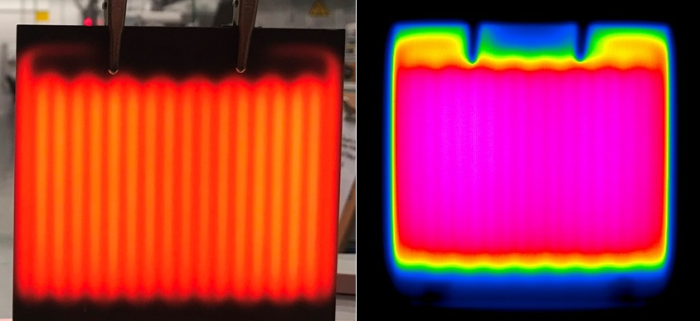
A black.infrared module (left) and thermal image showing temperature uniformity (right).
SOURCE | Heraeus Noblelight
Black IR advantages and potential composites applications
Fricks notes that black.infrared is not a filament-based IR emitter, which tends to be brighter in the center than on the sides. Instead, it produces a very uniform energy across the 2D, planar surface of the emitter, which can range in size from 40 millimeters by 400 millimeters up to 100 millimeters by 100 millimeters. “We can also tile the Black IR emitters to create a planar device up to 400 millimeters by 400 millimeters,” he adds.
Because black.infrared is a medium wave IR device, it’s relatively colorblind (white vs. dark), Fricks explains. “It won’t cook black materials or underheat yellow or white materials.” And yet, it reportedly takes less than 60 seconds to heat up. “Watt-for-watt, it’s not terribly expensive versus other IR options,” says Fricks. “IR is more expensive than a convection oven, but it offers speed and efficiency, as well as the ability to provide very uniform temperature — that is, variation less than plus or minus 5 degrees.”
Black IR could potentially be used in the production of fibers, prepregs, composite tapes and possibly chemical vapor deposition (CVD) processes like those use to make graphene and other nanocomposite materials. Fricks is seeking discussions with manufacturers and material suppliers to explore and develop further applications in composites.
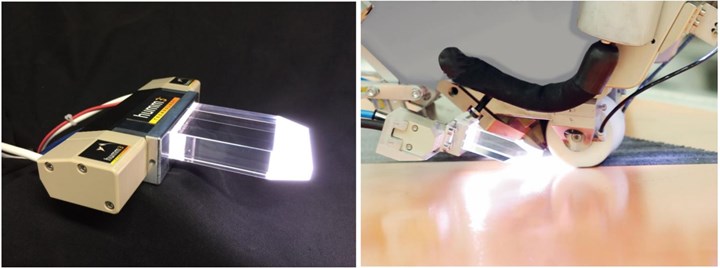
The humm3 system for automated fiber placement of thermoset, thermoplastic and dry fiber composites. SOURCE | Heraeus Noblelight
humm3 replacing lasers in AFP
The other technology that Heraeus Noblelight exhibited at CAMX 2018 was its humm3 system for automated fiber placement (AFP) of thermoset prepreg, dry fiber and thermoplastic composite tapes. The humm3 system uses a xenon-filled flashlamp that is pulsed multiple times per second. In part 2 of my 2018 article on in-situ consolidation of thermoplastic composites, I described in Fig. 2 how the lasers commonly used in thermoplastic AFP can be distinguished by their purple light vs. the orange light of the infrared (IR) heaters typically used in thermoset prepreg AFP. Notice that the humm3 technology is differentiated from both of these by its bright white light.
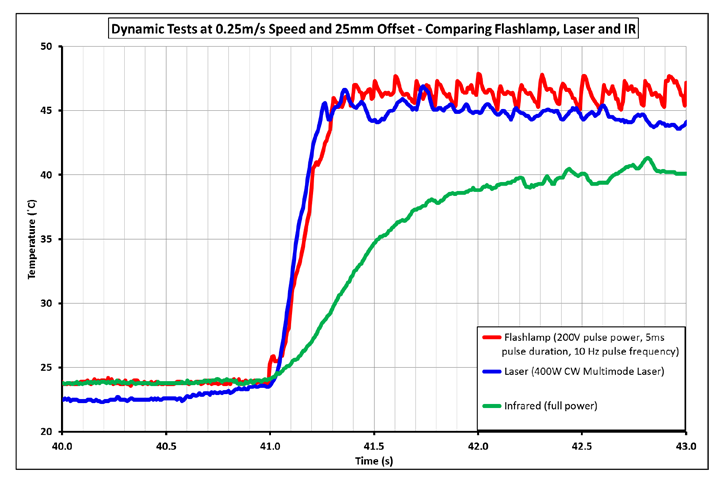
SOURCE | Heraeus Noblelight
“Infrared lamps are relatively inexpensive, but they are slow and cannot reach the high temperatures required by aerospace thermoplastics,” says Kyle Hudspeth, sales manager for Heraeus Noblelight’s humm3 system in North and South America. “On the other side, lasers are very fast to heat and cool, but they are expensive and require significant safety precautions. Humm3 fills a gap in the market for fast, safe, compact and cost-effective heating for AFP.”

Hudspeth explains that humm3 delivers uniform heat to the AFP nip point over a wide range of temperatures, from as low as 50°C to the currently measured maximum of 600°C. It can also be precisely controlled using three programmable parameters:
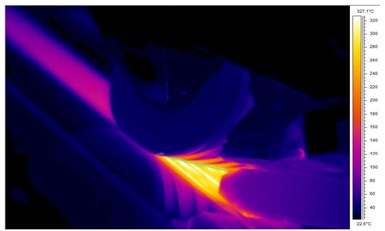
Thermal image of PEEK lay-up on a robotic AFP machine. The humm3 quartz delivery optic is seen at the right, pointing at the nip point between the substrate and incoming material. Speeds of 6 meters per minute were achieved with good quality results.
SOURCE | Heraeus Noblelight
- pulse energy (how large),
- pulse duration (how long)
- pulse frequency (how many times per second).
He adds that the heating time and temperature is roughly the same as with a laser, “but no protective laser booth is required, so technicians can be close to the layup during operation.”
In tests for processing carbon fiber-reinforced polyetheretherketone (PEEK) laminates, Heraeus Noblelight demonstrated that humm3 can produce high-quality thermoplastic AFP laminates with the ≈35% crystallinity and <2% porosity required for aerospace composite structures. As part of the EU’s Clean Sky 2 program, the Center for Lightweight Production Technology (ZLP, Stade, Germany) is working with Heraeus Noblelight to develop humm3 in the multi-robot GroFi system at the German Aerospace Center (DLR) in Stade. The work is aimed to significantly increase AFP rates for thermoplastic composite structures while meeting stringent quality requirements.
For dry fiber laminates that will be processed using resin infusion or resin transfer molding (RTM), Hudspeth claims humm3 enables a layup speed of 1 meter per second and uniform heating across eight or 16 tapes, each 0.25 inch wide. Heating across a width of 300 millimeters can be achieved with a single lamp and coordinated with the humm3’s modular power supply and modular design to further tailor an AFP system for even larger heated zones. The humm3 quartz delivery optic is also customizable to achieve a precise heat zone shape.
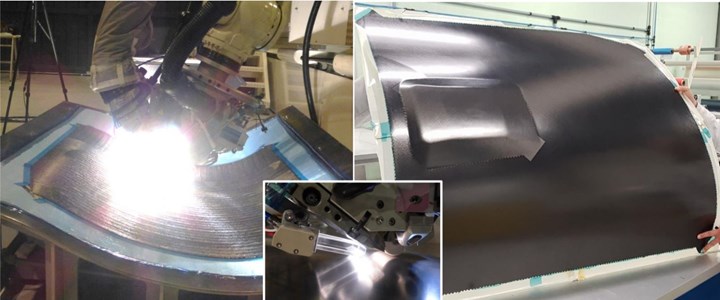
An aerospace part demonstrator using Hexcel’s HiTape dry fiber tape (left) and RTM6 resin (right). SOURCE | Heraeus Noblelight
The humm3 system is being developed for other composites processing, including thermoplastic welding, filament winding and tacking of multiple composite layers for preforms. Hudspeth notes humm3 is a mature, well-proven technology, demonstrated at the National Composites Centre (Bristol, UK) since 2016 and winner of the Queen’s Award for Innovation in the UK in 2015.
For more details, visit Heraeus Noblelight at CAMX booth Y47.

SOURCE | Heraeus Noblelight
Related Content
The potential for thermoplastic composite nacelles
Collins Aerospace draws on global team, decades of experience to demonstrate large, curved AFP and welded structures for the next generation of aircraft.
Read MoreMaterials & Processes: Composites fibers and resins
Compared to legacy materials like steel, aluminum, iron and titanium, composites are still coming of age, and only just now are being better understood by design and manufacturing engineers. However, composites’ physical properties — combined with unbeatable light weight — make them undeniably attractive.
Read MoreJeep all-composite roof receivers achieve steel performance at low mass
Ultrashort carbon fiber/PPA replaces steel on rooftop brackets to hold Jeep soft tops, hardtops.
Read MoreThe state of recycled carbon fiber
As the need for carbon fiber rises, can recycling fill the gap?
Read MoreRead Next
From the CW Archives: The tale of the thermoplastic cryotank
In 2006, guest columnist Bob Hartunian related the story of his efforts two decades prior, while at McDonnell Douglas, to develop a thermoplastic composite crytank for hydrogen storage. He learned a lot of lessons.
Read MoreComposites end markets: Energy (2024)
Composites are used widely in oil/gas, wind and other renewable energy applications. Despite market challenges, growth potential and innovation for composites continue.
Read MoreCW’s 2024 Top Shops survey offers new approach to benchmarking
Respondents that complete the survey by April 30, 2024, have the chance to be recognized as an honoree.
Read More















.jpg;maxWidth=300;quality=90)














